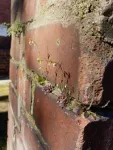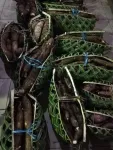Plant populations in Cologne are adapted to their urban environments
2023-11-02
(Press-News.org)
A research team from the Universities of Cologne and Potsdam and the Max Planck Institute for Plant Breeding Research has found that the regional lines of the thale cress (Arabidopsis thaliana), a small ruderal plant which populates the streets of Cologne, vary greatly in typical life cycle characteristics, such as the regulation of flowering and germination. This allows them to adapt their reproduction to local environmental conditions such as temperature and human disturbances. The researchers from Collaborative Research Center / Transregio 341 “Plant Ecological Genetics” found that environmental conditions filter out unsuited lines from a pool of regionally diverse plant lines, so that only the ones with suitable traits manage to survive. “This process, termed “environmental filtering”, is well-known for driving the establishment or persistence of plant species in a particular location. It is fascinating to see that exactly the same process also works for different lines within a species” says Anja Linstädter, who has recently left Cologne to become Professor in Biodiversity Research at the University of Potsdam. The study is reported in the article “Environmental filtering of life-history trait diversity in urban populations of Arabidopsis thaliana” published in the Journal of Ecology.
Arabidopsis thaliana is the most common model organism in plant research, and therefore important for plant biology. Most of the research work on A. thaliana focuses on the descendants of a single individual, a line called Col-0, while the naturally growing plants in the region of Cologne show a multiplicity of lines. “In our research consortium, we work on understanding how findings made in the lab manifest in nature”, explained Professor Dr Juliette de Meaux, spokesperson of CRC TRR 341. “At the beginning, what we asked ourselves is: does the lab line Col-0 resemble lines present naturally in Cologne? But then, we began to realize how much ecological diversity there is in our streets.”
The plants analysed in this study were collected by Dr Gregor Schmitz, the first author of the study, along his way to work. He noticed that A. thaliana was growing naturally in places with very different environmental conditions. These included patches with little water and nutrient supply such as small pavement cracks, but also highly disturbed habitats. When the scientists sequenced the plant genomes, they found that the urban lines were not more related to each other than to lines from a larger region.
To their surprise, the biologists found that there are large differences among A. thaliana populations in Cologne in respect to their life-cycle traits. These differences contribute to their persistence in habitats that mainly differ in how much they are disturbed by human activities such as weeding or mowing. “In other words, the genetic diversity we find throughout the city is not distributed at random, but matches specific differences in the urban environments,” said Schmitz.
Most plants use the cold to regulate the timing of flowering. In this way, they ensure that flowering does not take place in the middle of winter. In the streets of Cologne, the scientists found A. thaliana lines that use cold to regulate flowering, but also lines that do not use it: they flower very quickly after germinating. Also, the team discovered some lines with seeds that become dormant if they are exposed to high temperatures for a few days alongside lines whose seeds do not become dormant when it is hot. “The different lines can thus display very different life cycles,” said de Meaux. “Some are very fast, they need no dormancy and have no requirement for cold before flowering and others are slower, they have a high capacity to induce dormancy and cold is a requirement to flower. Such diversity across such a small area came as a surprise, but the most admirable was to see that it covaried with the gradient of environmental disturbance in our streets.”
The scientists will be further investigating how environmental heterogeneity selects specific genetic variants of urban Arabidopsis thaliana plants in Cologne.
END
[Attachments] See images for this press release:

ELSE PRESS RELEASES FROM THIS DATE:
2023-11-02
Though beer is a popular drink worldwide, it’s usually made from barley, which leaves those with a gluten allergy or intolerance unable to enjoy the frothy beverage. Sorghum, a naturally gluten-free grain, could be an alternative, but complex preparation steps have hampered its widespread adoption by brewers. Now, researchers reporting the molecular basis behind sorghum brewing in ACS’ Journal of Proteome Research have uncovered an enzyme that could improve the future of sorghum-based beers.
Traditionally, beer brewers start with barley grains, which they malt, mash, ...
2023-11-02
ITHACA, N.Y. –Things may not have ended well for dinosaurs on Earth, but Cornell University astronomers say the “light fingerprint” of the conditions that enabled them to emerge here provide a crucial missing piece in our search for signs of life on planets orbiting alien stars.
Their analysis of the most recent 540 million years of Earth’s evolution, known as the Phanerozoic Eon, finds that telescopes could better detect potential chemical signatures of life in the atmosphere of an Earth-like exoplanet more closely resembling the age the dinosaurs inhabited than the ...
2023-11-02
A re-analysis of more than 300 sets of 5,000-year-old skeletal remains excavated from a site in Spain suggests that many of the individuals may have been casualties of the earliest period of warfare in Europe, occurring over 1,000 years before the previous earliest known larger-scale conflict in the region. The study, published in Scientific Reports, indicates that both the number of injured individuals and the disproportionately high percentage of males affected suggest that the injuries resulted from a period of conflict, potentially lasting at least months.
Conflict during the European Neolithic period (approximately 9,000 ...
2023-11-02
University researchers from the UK, Germany and South Africa warn of a threat to scientific knowledge and the future of research in a paper published in Nature Human Behaviour, outlining the implications of changes to social media Application Programming Interfaces (APIs).
Over the course of 2023, numerous social media platforms including X, TikTok, and Reddit made substantial changes to their APIs – drastically reducing access or increasing charges for access, which the researchers say will in many cases make research harder.
APIs have been routinely tapped by researchers ...
2023-11-02
Evanston, IL. --- A team of researchers from the Mirkin Group at Northwestern University’s International Institute for Nanotechnology in collaboration with the University of Michigan and the Center for Cooperative Research in Biomaterials- CIC biomaGUNE, unveils a novel methodology to engineer colloidal quasicrystals using DNA-modified building blocks. Their study will be published in the journal Nature Materials under the title "Colloidal Quasicrystals Engineered with DNA."
Characterized ...
2023-11-02
Images
Nanoengineers have created a quasicrystal—a scientifically intriguing and technologically promising material structure—from nanoparticles using DNA, the molecule that encodes life.
The team, led by researchers at Northwestern University, the University of Michigan and the Center for Cooperative Research in Biomaterials in San Sebastian, Spain, reports the results in Nature Materials.
Unlike ordinary crystals, which are defined by a repeating structure, the patterns in quasicrystals don't repeat. Quasicrystals built from atoms can have exceptional properties—for ...
2023-11-02
Destructive winds that flow out of thunderstorms in the central United States are becoming more widespread with warming temperatures, according to new research by the U.S. National Science Foundation (NSF) National Center for Atmospheric Research (NCAR).
The new study, published this week in Nature Climate Change, shows that the central U.S. experienced a fivefold increase in the geographic area affected by damaging thunderstorm straight line winds in the past 40 years. The research uses a combination of meteorological observations, very high-resolution computer modeling, and analyses of fundamental ...
2023-11-02
Climate change is impeding the human rights of a large group of people living in the Pacific, a recent report in Nature reveals.
The paper substantiates a submission to the International Court of Justice (ICJ) on the legal responsibility of countries to act on climate change.
Evidence gathered in Vanuatu supports a clarification on loss and damage finance which could activate powerful legal tools to hold polluters accountable.
Research Fellow at the Griffith University Climate Action Beacon, Dr Ross Westoby said the report explores how climate-induced loss and damage in the Pacific is already occurring and outlines ...
2023-11-02
NEW YORK, November 2, 2023 — Harnessing and controlling light is vital for the development of technology, including energy harvesting, computation, communications, and biomedical sensing. Yet, in real-world scenarios, complexity in light's behavior poses challenges for its efficient control. Physicist Andrea Alù likens the behavior of light in chaotic systems to the initial break shot in a game of billiards.
“In billiards, tiny variations in the way you launch the cue ball will lead to different patterns of the balls bouncing around the table,” said Alù, Einstein ...
2023-11-02
It’s a multi-billion dollar question: What will happen to water as temperatures continue to rise? There will be winners and losers with any change that redistributes where, when and how much water is available for humans to drink and use.
To find answers and make informed predictions, scientists look to the past. Reconstructions of past climate change using geologic data have helped to show the far-reaching influence of human activity on temperatures since the Industrial Age. But assembling hydroclimate records for the same timeframe has proved to be much harder.
A study from the Past Global Changes (PAGES) Iso2k project team, ...
LAST 30 PRESS RELEASES:
[Press-News.org] Plant populations in Cologne are adapted to their urban environments


